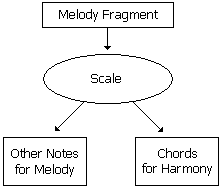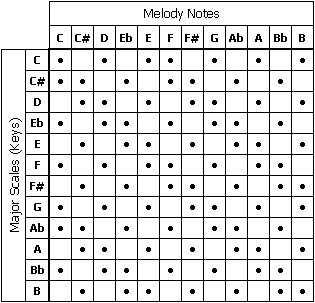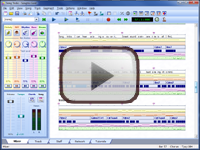(9.2) Starting with Melody
The first few starting notes of a melody are usually enough to give you a good idea of which scale the melody might be in.
Once you have worked out the scale, this will tell you which other notes you can use in the melody, and also which chords are likely to work well with the song.

You can use the table below to help you find which Major scale (if any) contains the notes in your melody fragment. However, it cannot help you in other situations where your notes belong to a different type of scale.

Most ChordWizard products contain the Notes To Scales tool, which offers a much quicker and easier way to identify a scale from a melody than the manual method described in this topic.
You simply enter the notes in your melody fragment, and you are instantly shown the related scales of all types and how closely they match.

Step 1. Decide which notes are contained in your melody fragment. Put them in order starting from note C. You will be looking these up in the column headings.
Step 2. Work down the row headings in the table. Wherever a row contains a dot in all the columns of your melody notes, this is a possible choice for the scale of your melody. Write it down.
Let's try this out with the first few notes of Twinkle Twinkle Little Star, shown below.

Step 1 tells us that our melody contains the notes C-D-E-F-G-A (in note order). Now following step 2, we work through each row in turn.
Row C: YES
Row C♯: No (does not contain D)
Row D: No (does not contain C)
Row E♭: No (does not contain E)
Row E: No (does not contain C)
Row F: YES
Row F♯: No (does not contain C)
Row G: No (does not contain F)
Row A♭: No (does not contain D)
Row A: No (does not contain C)
Row B♭: No (does not contain E)
Row B: No (does not contain C)
We end up with two choices for the scale of this melody, either C Major or F Major. Which is it? Our first clue comes from the starting and ending notes of the melody fragment, which is C, indicating that the key is probably C Major.
We can do a confirmation check by playing the home chord of each key (ie. Cmaj for C Major, and Fmaj for F Major) against the first few notes of the melody.

The Cmaj chord works much more strongly with the start of the melody, also indicating that C Major is the scale.
Knowing the scale our new song tells us that our melody could also use the note B (which is part of the C Major scale, but not yet used). It also highlights for us a group of chords - the related chords of C Major - that are likely to work well with our song.
|
Topic 109 of 117
| ||
Bring these music concepts to life with the free Songtrix Bronze Edition as you create songs from chords and scales.
Then publish and share your ideas with the other musicians you meet on the ChordWizard Network.
Have questions? Join the ChordWizard Network and post them in the Music Theory forum for answers and discussions on your topics of interest.








